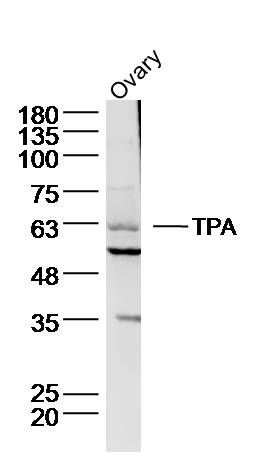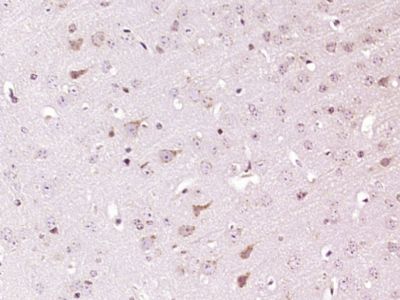产品中心
当前位置:首页>产品中心Anti-TPA
货号: bs-1545R 基本售价: 780.0 元 规格: 50ul
- 规格:50ul
- 价格:780.00元
- 规格:100ul
- 价格:1380.00元
- 规格:200ul
- 价格:2200.00元
产品信息
- 产品编号
- bs-1545R
- 英文名称
- TPA
- 中文名称
- 组织型纤溶酶原激活剂抗体
- 别 名
- TPA Tissue Plasminogen Activator; Plasminogen activator tissue; Plasminogen activator tissue type; Plasminogen Activator Tissue Type Isoform 1 Preproprotein; PLAT; Reteplase; t PA; t-PA; T Plasminogen Activator; Tissue plasminogen activator (t PA); PATISS; Tissue type plasminogen activator; TPA1; AU020998; AW212668; D8Ertd2e; MGC18508; TPA_HUMAN; Tissue-type plasminogen activator; t-plasminogen activator; Alteplase; Tissue-type plasminogen activator chain B.

- Specific References (1) | bs-1545R has been referenced in 1 publications.[IF=6.34] Balaoing, Liezl R., et al. "Age-Related Changes in Aortic Valve Hemostatic Protein Regulation." Arteriosclerosis, Thrombosis, and Vascular Biology (2013): ATVBAHA-113. IHC-P ; Pig.PubMed:24177329
- 规格价格
- 50ul/780元购买 100ul/1380元购买 200ul/2200元购买 大包装/询价
- 说 明 书
- 50ul 100ul 200ul
- 研究领域
- 心血管 免疫学 神经生物学 激酶和磷酸酶
- 抗体来源
- Rabbit
- 克隆类型
- Polyclonal
- 交叉反应
- Human, Mouse, Rat, Pig, Cow, Horse, Rabbit,
- 产品应用
- WB=1:500-2000 ELISA=1:500-1000 IHC-P=1:400-800 IHC-F=1:400-800 IF=1:100-500 (石蜡切片需做抗原修复)
not yet tested in other applications.
optimal dilutions/concentrations should be determined by the end user.
- 分 子 量
- 28/58kDa
- 细胞定位
- 分泌型蛋白
- 性 状
- Lyophilized or Liquid
- 浓 度
- 1mg/ml
- 免 疫 原
- KLH conjugated synthetic peptide derived from human Tissue-type plasminogen activator chain B:485-562/562
- 亚 型
- IgG
- 纯化方法
- affinity purified by Protein A
- 储 存 液
- 0.01M TBS(pH7.4) with 1% BSA, 0.03% Proclin300 and 50% Glycerol.
- 保存条件
- Store at -20 °C for one year. Avoid repeated freeze/thaw cycles. The lyophilized antibody is stable at room temperature for at least one month and for greater than a year when kept at -20°C. When reconstituted in sterile pH 7.4 0.01M PBS or diluent of antibody the antibody is stable for at least two weeks at 2-4 °C.
- PubMed
- PubMed
- 产品介绍
- background:
This gene encodes tissue-type plasminogen activator, a secreted serine protease which converts the proenzyme plasminogen to plasmin, a fibrinolytic enzyme. Tissue-type plasminogen activator is synthesized as a single chain which is cleaved by plasmin to a two chain disulfide linked protein. This enzyme plays a role in cell migration and tissue remodeling. Increased enzymatic activity causes hyperfibrinolysis, which manifests as excessive bleeding; decreased activity leads to hypofibrinolysis which can result in thrombosis or embolism. Alternative splicing of this gene results in multiple transcript variants encoding different isoforms. [provided by RefSeq, Jul 2008].
Function:
Converts the abundant, but inactive, zymogen plasminogen to plasmin by hydrolyzing a single Arg-Val bond in plasminogen. By controlling plasmin-mediated proteolysis, it plays an important role in tissue remodeling and degradation, in cell migration and many other physiopathological events. Plays a direct role in facilitating neuronal migration.
Subunit:
Heterodimer of chain A and chain B held by a disulfide bond. Forms a heterodimer with SERPINA5. Binds to fibrin with high affinity. This interaction leads to an increase in the catalytic efficiency of the enzyme between 100-fold and 1000-fold, due to an increase in affinity for plasminogen. Similarly, binding to heparin increases the activation of plasminogen. Binds to annexin A2, cytokeratin-8, fibronectin and laminin. Binds to mannose receptor and the low-density lipoprotein receptor-related protein (LRP1); these proteins are involved in TPA clearance. Yet unidentified interactions on endothelial cells and vascular smooth muscle cells (VSMC) lead to a 100-fold stimulation of plasminogen activation. In addition, binding to VSMC reduces TPA inhibition by PAI-1 by 30-fold. Binds LRP1B; binding is followed by internalization and degradation.
Subcellular Location:
Secreted.
Tissue Specificity:
Synthesized in numerous tissues (including tumors) and secreted into most extracellular body fluids, such as plasma, uterine fluid, saliva, gingival crevicular fluid, tears, seminal fluid, and milk.
Post-translational modifications:
The single chain, almost fully active enzyme, can be further processed into a two-chain fully active form by a cleavage after Arg-310 catalyzed by plasmin, tissue kallikrein or factor Xa.
Differential cell-specific N-linked glycosylation gives rise to two glycoforms, type I (glycosylated at Asn-219) and type II (not glycosylated at Asn-219). The single chain type I glycoform is less readily converted into the two-chain form by plasmin, and the two-chain type I glycoform has a lower activity than the two-chain type II glycoform in the presence of fibrin.
N-glycosylation of Asn-152; the bound oligomannosidic glycan is involved in the interaction with the mannose receptor.
Characterization of O-linked glycan was studied in Bowes melanoma cell line.
DISEASE:
Note=Increased activity of TPA results in increased fibrinolysis of fibrin blood clots that is associated with excessive bleeding. Defective release of TPA results in hypofibrinolysis that can lead to thrombosis or embolism.
Similarity:
Belongs to the peptidase S1 family.
Contains 1 EGF-like domain.
Contains 1 fibronectin type-I domain.
Contains 2 kringle domains.
Contains 1 peptidase S1 domain.
SWISS:
P00750
Gene ID:
5327
Database links:Entrez Gene: 5327 Human
Omim: 173370 Human
SwissProt: P00750 Human
Unigene: 491582 Human
Important Note:
This product as supplied is intended for research use only, not for use in human, therapeutic or diagnostic applications.
组织型纤溶酶原激活剂tPA是丝氨酸蛋白酶家族的一员,其主要的生物学功能是激活纤溶酶原转变为纤溶酶.
近年来经研究表明t-PA参与循环系统的溶血栓过程之外,t-PA还在神经系统中也发挥了重要的作用,t-PA参与了癫痫和早老型痴呆症等神经系统疾病的发生和发展,在学习和记忆等生理过程中也发挥了重要作用。
- 产品图片
 Sample:
Sample:
Ovary (Mouse) Lysate at 40 ug
Primary: Anti-TPA (bs-1545R) at 1/300 dilution
Secondary: IRDye800CW Goat Anti-Rabbit IgG at 1/20000 dilution
Predicted band size: 62 kD
Observed band size: 62 kD Paraformaldehyde-fixed, paraffin embedded (Mouse brain); Antigen retrieval by boiling in sodium citrate buffer (pH6.0) for 15min; Block endogenous peroxidase by 3% hydrogen peroxide for 20 minutes; Blocking buffer (normal goat serum) at 37°C for 30min; Antibody incubation with (TPA) Polyclonal Antibody, Unconjugated (bs-1545R) at 1:400 overnight at 4°C, followed by operating according to SP Kit(Rabbit) (sp-0023) instructionsand DAB staining.
Paraformaldehyde-fixed, paraffin embedded (Mouse brain); Antigen retrieval by boiling in sodium citrate buffer (pH6.0) for 15min; Block endogenous peroxidase by 3% hydrogen peroxide for 20 minutes; Blocking buffer (normal goat serum) at 37°C for 30min; Antibody incubation with (TPA) Polyclonal Antibody, Unconjugated (bs-1545R) at 1:400 overnight at 4°C, followed by operating according to SP Kit(Rabbit) (sp-0023) instructionsand DAB staining.

